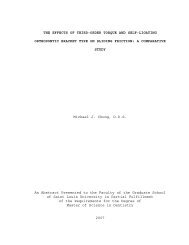Celebrating Father Biondi's Anniversary - Saint Louis University
Celebrating Father Biondi's Anniversary - Saint Louis University
Celebrating Father Biondi's Anniversary - Saint Louis University
Create successful ePaper yourself
Turn your PDF publications into a flip-book with our unique Google optimized e-Paper software.
Photos by James Visser<br />
TreASUreS TO BeHOLD AnD TO Be HeLD<br />
– By Marie Dilg<br />
Those who believe you cannot judge<br />
a book by its cover could learn a little<br />
something from Dr. Gregory A. Pass.<br />
He is in the basement vault of Pius XII Memorial Library carefully holding a small book with a<br />
well-worn cover. The volume, a New Testament in Syriac bound together with a lexicon of Syriac<br />
and critical notes, is a rare and important early printed edition in the history of the Bible.<br />
“These books were printed between 1664 and 1667, and bound together in 1686, as indicated<br />
by the date stamped in gold on the cover. The top, bottom and front edges of the pages<br />
have been elaborately gilded, and the entire volume is bound in vellum. Vellum generally is<br />
less expensive than leather, but the gold-stamped designs on the cover and the elegant details<br />
suggest this volume did not belong to a starving Syriac scholar. The gauffered (tooled) edges of<br />
the pages also indicate that someone with considerable means would have owned this.”<br />
Pass slides the book back onto a shelf in the vault that is filled with thousands of ancient<br />
volumes. To Pass, however, these are not just old books. They are artifacts. His mission as head<br />
of Special Collections is not only to preserve these artifacts and their texts but also to make<br />
them accessible to SLU students and to scholars worldwide who are interested in exploring how<br />
the written word was produced, consumed and understood over the centuries.<br />
Page Turner<br />
Evidence indicates SLU began a separate collection for its rare books around the time of the<br />
Civil War. Some of the books were purchased. Some were donated. Many came to the <strong>University</strong><br />
from monasteries and mission houses when they closed. In all, the <strong>University</strong> has collected<br />
approximately 12,000 volumes printed before 1820 and 15,000 after 1820.<br />
Librarians use 1820 as the dividing line because books were printed on hand presses until<br />
around 1820 and then increasingly on steam-driven presses at a higher volume and with<br />
greater uniformity after 1820.<br />
SLU’s rare book collection is strong in Catholic theology, history and philosophy, including<br />
various editions of works by St. Thomas Aquinas and St. Augustine. It contains numerous<br />
titles by members of the Society of Jesus, including Ignatius Loyola, Francis Xavier and<br />
Francisco Suárez. Nearly half of the collection is in Latin. The collection also has strengths in<br />
American history, the Civil War, St. <strong>Louis</strong> area history, American Catholic Church history and<br />
Jesuit missionary activities in the Americas.<br />
Books not kept in the vault are in closed<br />
stacks like those in the St. <strong>Louis</strong> Room on<br />
the third floor of Pius, where Pass is displaying<br />
several of the collection’s treasures. He<br />
places them on soft gray book rests to protect<br />
their bindings.<br />
From the shelf he has pulled:<br />
Several volumes by Athanasius Kircher, a<br />
17th-century German Jesuit scholar who<br />
published broadly, most notably on China,<br />
Egypt, geology, science and medicine.<br />
SLU has a rare 1667 copy of Kircher’s<br />
China Monumentis — complete with foldout<br />
maps and rich illustrations of Chinese<br />
dress. This book provided the West with<br />
some of its earliest images of China. Also<br />
in SLU’s collection is Kircher’s Sphinx<br />
Mystigoga, an early attempt at deciphering<br />
hieroglyphics that remained the standard<br />
work on the subject until the 19th century.<br />
Five manuscript leaves from the famous<br />
15th-century Llangattock Breviary (a liturgical<br />
book of prayers and hymns) illuminated<br />
in Italy. SLU has one of the largest concentrations<br />
of leaves from this book.<br />
A second edition of Oliver Twist printed in<br />
1839 in three volumes (known as a triple<br />
decker) with original illustrations.<br />
First edition copies of Mark Twain’s Huckleberry<br />
Finn and Life on the Mississippi with<br />
original illustrations and publishers’ decorative<br />
bindings.<br />
Pass believes these books are important to<br />
preserve in their original form, not only for<br />
the texts they contain but also because of the<br />
physical attributes of the objects themselves —<br />
the binding, paper, typography and illustrations.<br />
Together these elements influence how<br />
the texts originally were read and circulated.<br />
“You can go into any bookstore and buy a<br />
copy of Huckleberry Finn,” Pass said. “It’s a<br />
very common text. But if you’re an English<br />
professor trying to help your students understand<br />
how the novel was read and how it fit<br />
into society, it’s much more effective to show<br />
them a first edition copy with original illustrations<br />
and binding.<br />
“You’re holding history.”<br />
Dr. Phillip R. Gavitt, associate professor<br />
of history, agrees that the artifacts have<br />
educational impact. Gavitt joined SLU 15<br />
years ago in part because of the holdings in<br />
Special Collections. Access to them greatly<br />
benefits his research into medieval and early<br />
modern Italian history.<br />
16 UNIVERSITAS www.slu.edu UNIVERSITAS FALL 2007 17<br />
Dr. gregOry PASS
















